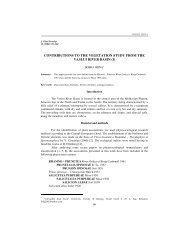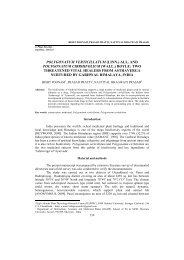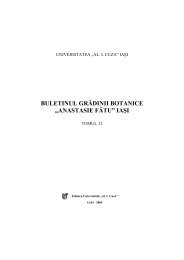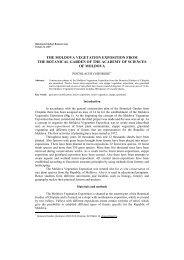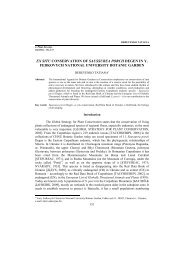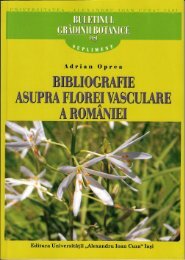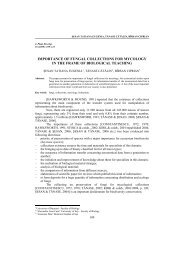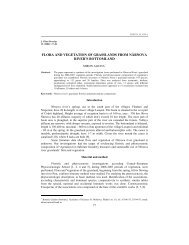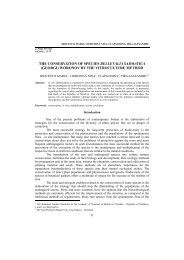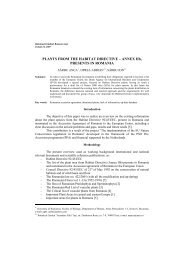taxonomic and ecologic structure of communities of edaphic algae ...
taxonomic and ecologic structure of communities of edaphic algae ...
taxonomic and ecologic structure of communities of edaphic algae ...
You also want an ePaper? Increase the reach of your titles
YUMPU automatically turns print PDFs into web optimized ePapers that Google loves.
TAXONOMIC AND ECOLOGIC STRUCTURE OF COMMUNITIES OF EDAPHIC ALGAE ….<br />
Results <strong>and</strong> discussions<br />
The investigations made on <strong>algae</strong> <strong>communities</strong> have shown a varied alg<strong>of</strong>lora, both by<br />
the <strong>taxonomic</strong> <strong>structure</strong> <strong>and</strong> by the biologic particularities <strong>of</strong> species, which includes a total <strong>of</strong><br />
63 species <strong>and</strong> genera <strong>of</strong> <strong>algae</strong> from 10 families <strong>and</strong> 22 genera. The largest number <strong>of</strong> <strong>algae</strong> has<br />
been detected on agricultural l<strong>and</strong>s occupied by barley, sunflower <strong>and</strong> corn cultures, <strong>and</strong> the<br />
minimum value has been identified in wheat <strong>and</strong> sugar beet cultures. If we speak about the<br />
<strong>structure</strong> <strong>of</strong> phyla, the development <strong>of</strong> green-blue <strong>algae</strong> is predominant in all the cultures.<br />
The second place by the variety <strong>of</strong> species is held by bacillariophyta that vegetate<br />
actively in the soil occupied by barley <strong>and</strong> potato cultures. The relatively high diversity is<br />
probably due to the use <strong>of</strong> water from reservoirs for irrigation. Thus, these two groups<br />
make up from the number <strong>of</strong> <strong>algae</strong>.<br />
The most sensible are the xantophyta <strong>algae</strong> that are present only in the fields <strong>of</strong> wheat <strong>and</strong> soya,<br />
which shows the lack <strong>of</strong> pollution with chemical substances (pesticides, herbicides, etc.).<br />
The Euglenophyta have disappeared from the list <strong>of</strong> species, which proves that they are not<br />
typical <strong>of</strong> algocenoses from the soil (tab. 1).<br />
Table 1<br />
Taxonomic <strong>structure</strong> <strong>of</strong> <strong>algae</strong> <strong>communities</strong> that vegetate the agrocenoses in the north <strong>of</strong> Moldova.<br />
Fields with<br />
cultures<br />
Groups<br />
<strong>of</strong> <strong>algae</strong><br />
Potato Soya Sunflower Corn Barley Wheat Sugar beet Lucern<br />
Cyanophyta 11 12 15 13 20 7 7 12<br />
Chlorophyta 1 - 1 1 2 1 3 1<br />
Xantophyta - 1 - - - 2 - -<br />
Bacilariophyta 2 2 1 2 5 2 - 2<br />
Euglenophyta - - - - - - - -<br />
Total no. <strong>of</strong> sp. 14 15 17 16 27 12 10 15<br />
Data from the previous table on the distribution <strong>of</strong> species by phyla show that the<br />
established laws are generally maintained:<br />
Cyanophyta (46) – Bacilariophyta(6) – Xantophyta (3) – Chlorophyta (8) —<br />
Euglenophyta (missing). The field with sunflower culture is predominantly occupied by cyanophyta,<br />
soya has two species <strong>of</strong> diatom from the Navicula variety, as compared to algocenosis from the<br />
wheat culture that includes all the representatives <strong>of</strong> phyla (tab. 1), a pro<strong>of</strong> <strong>of</strong> the optimal conditions<br />
for the development <strong>of</strong> <strong>edaphic</strong> <strong>algae</strong>.<br />
By comparing the <strong>structure</strong> <strong>of</strong> predominant species in cultivated crops <strong>and</strong> noncultivated<br />
crops, we can see that there are differences. For instance, agrocenoses with cultivated<br />
crops are dominated by Phormidium species (Ph. molie, Ph. jadinianum, Ph. foveolarum) <strong>and</strong><br />
Nostoc, the non-cultivated crops are dominated by Phormidium species <strong>and</strong> by Lyngbia species (L.<br />
cryptovaginata, L. attenuata, L. martensiana), the intensive development creates a gelatinous film<br />
on the soil surface. Thus, the action <strong>of</strong> mechanic soil processing creates unstable <strong>and</strong> diverse<br />
4



